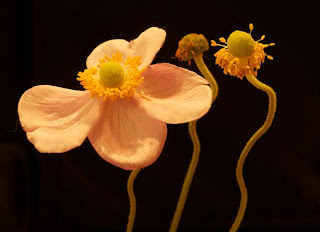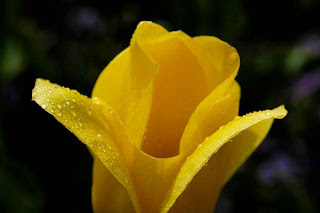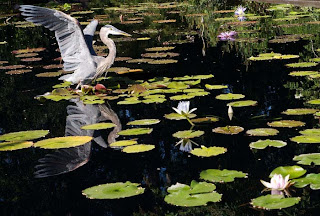Ever look at the fabulous landscape and plant photographs that you see in magazines and wonder what the secret is? Luckily for us there is no secret, and you don’t need top of the line equipment to make a great picture. I spoke with professional photographers and business partners Mark Riedy and John Wigmore, who will be leading a 3-week series of workshops beginning Saturday about what photographers can do to improve their ability to visualize and make good photographs.
A great photographer can take a spectacular photograph with a point-and-shoot camera. It is the vision and skill of the photographer, not the tool, that makes a picture.
Learn to Look
Looking at great photographs is important for developing an eye for what makes a compelling image and for becoming more sensitive to the way that a camera sees and how it is different from the way that we see.
If you spend time studying the pictures in garden magazines and visiting local photography exhibitions, you are already doing this. To get more out of looking at pictures, try this exercise. Ask yourself what is the story being told by an image? How does the photographer convey this? Is the arrangement of the formal elements in the picture pleasing? Why or why not? How does the photographer use color, contrast and texture?
Learn the Methods
Beyond learning from looking at great photographs, learning the working methods of great photographers is important to developing your inner vision, according to Riedy and Wigmore. In their classes, they will demonstrate how to effectively use compositional elements like color, tone and contrast in order to create a stunning photograph.
Take the great landscape photographer Ansel Adams, for example. Adams’ work emphasizes tonal range and stark contrasts between black and white forms to convey the drama of the western landscape.
Eliot Porter, who was strongly influenced by Adams, is another photographer worth study and emulation. Porter’s work often takes on the story of the changing seasons. He conveys this story and heightens our interest in it by emphasizing the contrasting textures of his subjects and by showing off the rich hues of the natural world.
How might you introduce dynamic qualities like these to your photographs?
 Photo by Mark Riedy
Photo by Mark RiedyPut it into practice
Now that you're feeling inspired, it's time to take these techniques to the field. When you get to a spot you'd like to photograph, ask yourself what it is about this place or subject that draws you to photography it? What story does this place or subject have to tell? What is the best way to tell it?
Before picking up your camera, visualize the effects that different artistic decisions will have on a finished image. Walk around your subject and think about possible camera positions. Notice that by changing the position of the camera, an object can appear larger or smaller or closer or farther from the viewer.
The effects of shutter speed are also worth considering before beginning to shoot-particularly if your subject is moving. Capturing flowing water or long grasses swaying in a breeze with a slow or fast shutter speed, for example, yield images with different sense of time. Whereas a fast shutter speed of a subject in motion yields an image in which the subject appears frozen in time, a slow shutter speed yields a blurred effect that relates the subject's motion over a passage of time.
Keep in mind the things that you found exciting about the images of other photographers and think about how you can incorporate some of those elements in your work.
And remember that practice is the key. As Adams relates of his own photographic process:
“In my mind’s eye, I visualize how a particular … sight and feeling will appear on a print. If it excites me, there is a good chance it will make a good photograph. It is an intuitive sense, an ability that comes from a lot of practice.”
Before picking up your camera, visualize the effects that different artistic decisions will have on a finished image. Walk around your subject and think about possible camera positions. Notice that by changing the position of the camera, an object can appear larger or smaller or closer or farther from the viewer.
The effects of shutter speed are also worth considering before beginning to shoot-particularly if your subject is moving. Capturing flowing water or long grasses swaying in a breeze with a slow or fast shutter speed, for example, yield images with different sense of time. Whereas a fast shutter speed of a subject in motion yields an image in which the subject appears frozen in time, a slow shutter speed yields a blurred effect that relates the subject's motion over a passage of time.
Keep in mind the things that you found exciting about the images of other photographers and think about how you can incorporate some of those elements in your work.
And remember that practice is the key. As Adams relates of his own photographic process:
“In my mind’s eye, I visualize how a particular … sight and feeling will appear on a print. If it excites me, there is a good chance it will make a good photograph. It is an intuitive sense, an ability that comes from a lot of practice.”
For more advice on how to develop your vision, as well as a chance to practice, consider signing up for “Learn from the Masters.” The Saturday workshop series will run from 8 to 10 a.m. March 31 and April 7 and 14. The class is limited to 20 participants. The fee is: $95; $75 for Gardens members.
To register, please call 919-668-1707. For more information, please email our registrar. To learn more about classes at Duke Gardens, please visit the education/events page, or see a quick rundown on this blog post.
Sarah P. Duke Gardens creates and nurtures an environment in the heart of Duke University for learning, inspiration and enjoyment through excellence in horticulture. The Gardens is at 420 Anderson St.
Below are more stunning photographs from Riedy and Wigmore.
 Photo by Mark Riedy
Photo by Mark Riedy











